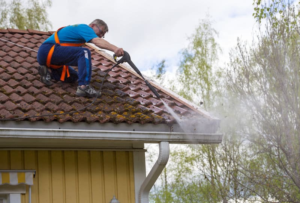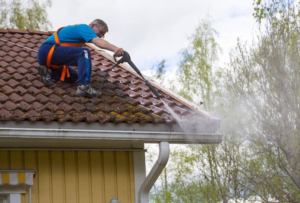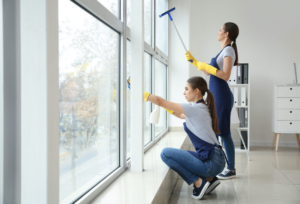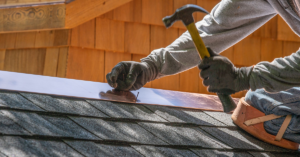Though advances in asphalt shingle technology have made them less prone to algae, mildew, moss, and those unattractive black streaks, cleaning is still necessary. It not only improves your home’s curb appeal, it prolongs the life of your roof.
Before beginning the process, thoroughly rinse your roof with a hose to remove any loose debris. Next, carefully apply the cleaning solution as directed on the label. Contact Roof Cleaning MT Pleasant now!

Chemical roof cleaning is a great way to remove organic growth like moss and algae on your home’s roofing materials. It involves using a chemical solution that breaks down and kills the organisms and loosening dirt so that it can be rinsed away with water. The chemicals are diluted to make them safe for use on most roofing materials without damaging or voiding their warranties. The chemical treatments are also safer for the environment than high-strength pressure washing, which can cause damage to the shingles and leave behind dangerous pollutants.
The most popular chemical for soft wash roof cleaning is sodium hypochlorite, or bleach. It is a powerful degreaser and heavy-duty oxidizer that can lighten or completely remove most stains from organic material on the roof. It can be used alone or with other chemicals, including trisodium phosphate (TSP), an enhancer, and alcohol.
A chemical solution that contains a mixture of copper sulfate, sodium hypochlorite, and sodium percarbonate is another common choice for soft wash roof cleaning. This combination has proven to be effective in killing fungi and moss on most roofing materials. It can be used alone or with surfactants to create a cleaner that penetrates deeply into the surface of the roof and kills the organisms at their roots.
When you’re looking for a roof cleaning company that offers chemical treatments, be sure to choose one with experience and knowledge of proper application. A professional can ensure that the chemical treatment is properly mixed, applied, and disposed of to provide optimal results without damaging the roof or causing environmental harm.
While pressure washing can be a good option for removing surface-level debris, it’s not always as effective against moss or algae. It’s important to use a chemical solution that is designed to kill the organisms at their roots, which will keep them from returning for a longer period of time. Benz Softwash Lightning Cleanze, for example, is a gentle chemical that can be diluted to safely clean most surfaces and is specifically formulated for cleaning lichen and moss on rooftops.
Pressure Washing
Pressure washing is an effective way to remove dirt and stains from the surface of a roof. However, it is important to choose the right pressure for your cleaning needs. Too high a pressure can damage the roof, leaving it vulnerable to further damage and shortening its lifespan. A professional cleaning service will help you determine the right pressure for your roof type and soil conditions.
The first step to pressure washing is to prepare the area around your home’s exterior. This includes covering delicate plants and ensuring that any electrical components are properly protected from the water. It is also important to cover any windows and doors that could be damaged by the powerful water stream. A professional cleaning service will take the time to make sure that all areas are safe before beginning the clean-up process.
It is also important to consider the weather conditions when selecting a cleaning method for your roof. Rain can decrease the effectiveness of a pressure wash and may even cause it to damage your roof. For this reason, brushing is often a better option for light build-ups of dirt and stains.
Pressure washing requires the use of powerful water streams to penetrate deep into crevices and remove dirt, mildew, and moss growth from the surface of the roof. It is an effective method for eliminating stubborn stains and is recommended for roofs that are not stained heavily. It is also important to hire a professional to perform this cleaning because it can be dangerous if not done correctly.
The gentler alternative to power washing is soft washing, which uses less than 1,000 PSI of pressurized water with biodegradable detergents and chemicals. This method is suitable for most roofing types, including shingles, tiles, and metal. In addition, it is safe for most vinyl siding, stucco, and wood surfaces. It is also safe for most gutter systems and does not strip away the protective coating on shingles.
Soft washing can be performed on your own using a garden hose or other low-pressure sprayers, but it is best to leave the job to professionals who have the equipment and experience necessary to safely and thoroughly clean your roof. They will ensure that the proper cleaning solution is used to prevent future build-ups. They will also check that the roof and surrounding areas are free of debris and dirt. They will then rinse the chemicals and debris from the surface of the roof.
Chlorine Bleach Roof Cleaning
Bleach is an effective chemical cleaner that eliminates fungus, mold and algae as well as the stains they leave behind. It can also help restore roofs that have been damaged by harsh weather or pests. But if you’re looking for safe roof cleaning, it’s best to avoid bleach and stick with non-toxic cleaners.
Bleach can cause a wide range of health problems when used incorrectly. It’s important to follow the manufacturer’s instructions and dilute it properly. You can get a better result if you apply the cleaner to a dry, clean roof surface before spraying it. This will ensure that the bleach can reach the contaminants without causing damage to the shingles or other roof materials.
Using a low-pressure sprayer to distribute the bleach and water mixture over the roof will ensure that all areas are treated evenly. It’s also helpful to remove any debris, large patches of dirt or loose materials before applying the cleaner. This will allow the cleaner to directly target the contaminants and make them easier to rinse away.
When choosing a roof cleaning company, it’s important to find one that has a good track record. Look for customer reviews and testimonials, as these can give you a better idea of how the company performs. You can also check out independent research and comparative studies to see how different cleaners perform.
Many roof-cleaning specialists use a combination of chlorine bleach and trisodium phosphate (TSP) to clean roofs. They spray the solution onto the roof, and it removes stains in about 15 minutes. This method is less expensive than others, and it doesn’t require a ladder or a power washer.
But the bleach can be toxic to plants, pets and humans if it’s not rinsed off properly. It can leave a strong chemical odor and create respiratory irritation and skin burns if it’s inhaled or contacted. In addition, runoff from high-strength bleach can harm vegetation and contaminate water sources.
A safer option is to use an organic cleaner, such as rinsing the roof with water. It’s also important to use a pressure washer with a low-pressure setting. High-pressure cleaners can damage shingles and aggravate existing roofing issues.
Organic Roof Cleaning
When dirt, debris and organic matter accumulate on a roof, they can cause problems like clogged gutters, mildew growth or even moss growth. These conditions not only affect the appearance of a home but can also lead to leaks and damage, often requiring costly repairs or early roof replacement. Regular cleaning of a roof is essential for preventing these conditions from developing, and many homeowners opt to use chemical methods such as power washing or bleaching. However, there are eco-friendly alternatives that can be just as effective and safe for the environment and homeowners.
The process of organic roof cleaning uses biodegradable cleansers to break down organic material and loosen it from the surface of a roof. This allows the homeowner to rinse the roof using low-pressure water, which removes the organic material and leaves the roof looking new again. This method is especially useful for homeowners who prefer not to use harsh chemicals on their roofs.
There are a variety of organic cleaners available for use on roofs, including products like Wash Safe and Citra-Shield Concentrate. These treatments work to inhibit the growth of fungus, moss and mildew by blocking their ability to absorb visible light. These products are also non-toxic and non-alkaline, working to preserve a roof’s structure while eliminating organic growth. These treatments are also effective on shingles, working to prevent staining and providing a longer lifespan for the roofing materials.
After applying the cleaner, homeowners should allow it to dwell on the roof for 10 to 20 minutes, allowing the product to penetrate and breakdown organic growth and kill any spores that are present. The roof should then be thoroughly rinsed using fresh, low-pressure water. The same nozzle and wand used to apply the cleaner can be used for rinsing, which ensures that all cleaning solution and dead organic material is removed from the surface of the roof.
The benefits of regular roof cleaning include a healthier and more attractive home, reduced water runoff and fewer leaks and repairs, and a decreased need for frequent roof replacements. Other advantages include the fact that eco-friendly cleaning methods are safer for the environment, minimizing risk of harming vegetation and wildlife while contributing to sustainability and resource conservation.


